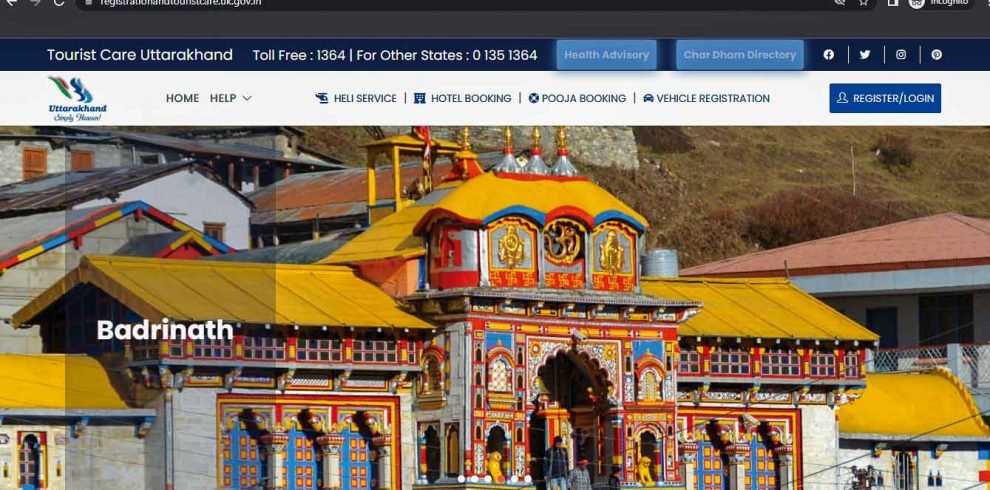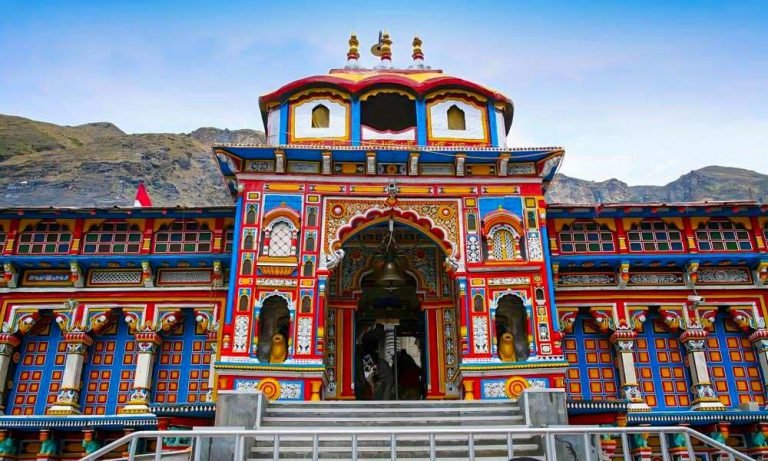Home > Char Dham Yatra | Travel Guide to Char Dham
Kedarnath, Badrinath, Gangotri, and Yamunotri temples in the Uttarakhand Himalayas are famous as “Chota Char Dham of India,” and pilgrimage to these sacred places is known as “Char Dham Yatra or 4 Dham yatra.”
In Chardham, each temple is dedicated to a particular deity,
The Char Dham Yatra is significant in the Hindu religion, and it is believed that every Hindu should do it at least once in their lifetime. 4 Dham yatra is a journey that a pilgrim undertakes to enlighten one’s inner self.
41 Lakh Pilgrims have traveled to Chota Char Dham in 2022, a record-breaking figure. On 21st October, Pm “Modi” also visited the Kedarnath Dham.
The Chardham Yatra is considered of great significance for Hindus. Home to many temples and pilgrimage sites, the divine Char Dhams are situated in Uttarakhand. According to traditional mythologies, every Hindu should travel to Char Dham at least once during his lifetime. This is because of the belief that by repenting for a lifetime’s worth of sins, the Char Dham Yatra opens the doors to “Moksha.”
For Hindus, Adi Shankaraya Charya was a vedic Scholar and teacher. He is praised and given credit for bringing Hinduism back to life. Hinduism’s Char Dham Yatra Pilgrimage circuit is one of the many pilgrimage sites he constructed. The Pilgrims are reminded of their illustrious past while in Char Dhams. It is said that after completing the Chardham Yatra, a pilgrim finds absolute tranquillity.
This Char Dham Yatra is noteworthy from both a spiritual and scientific point of view. The mountain air refreshes the soul and connects the pilgrims to nature. In addition, the challenging trip pushes one beyond his comfort zone.
Char Dham Yatra is only open for six months a year, starting in April/May and ending in October/November before heavy snowfall cuts off access to shrines.
Given below is a list of Char Dham Yatra opening and closing dates for 2023:
| Char Dham Shrines | Opening Date | Closing Date (Tentative) |
| Yamunotri | 22-April-2023 | 14-November-2023 |
| Gangotri | 22-April-2023 | 13-November-2023 |
| Kedarnath | 25-April-2023 | 14-November-2023 |
| Badrinath | 27-April-2023 | 21-November-2023 |
On the holy day of Maha Shivratri, the Kedar-Badri Mandir Samiti discloses the specific dates for the opening and closure of the Char Dham Yatra. The dates are set after reviewing the sacred Hindu calendar, Panchang.
The holy Yatra of 4 Dham can be done during the 6 months when the shrines are open for pilgrims. All the temples of the Char Dham are prone to extreme weather conditions due to their location. So, it becomes important for travellers to check the weather before going on a trip.
The months of May and June are considered the Best time for Char Dham Yatra since the climate is favourable, with pleasant temperatures, neither too hot nor too cold for travel. After this, from July onwards, the monsoon onsets in Uttarakhand, making it inconvenient and difficult to travel to Char Dham during this period.
After the monsoon’s departure, there is another good time for Char Dham Yatra in the pre-winter season, from the end of September to the middle of November. During this time, the valleys are in full bloom with thick and beautiful vegetation after a heavy monsoon making it an excellent time to embark on the Char Dham yatra in Uttarakhand.
Here is an easy flowchart to understand the entire Char Dham yatra route:-
Haridwar → Dharasu → Yamunotri → Uttarkashi → Gangotri → Rudraprayag → Kedarnath → Rudraprayag → Badrinath
© we-cabs.com
The holy Char Dham yatra usually begins from Haridwar, also known as the “Gateway to Gods,” which is well linked to all four sacred shrines. According to Hindu beliefs, the pilgrimage to the four temples is to be done clockwise from Yamunotri to Gangotri, then Kedarnath and Badrinath.
The pilgrimage will begin in Rishikesh, from which you will travel to Dharasu. Then after about an hour and a half of travel, you will reach your first destination, Yamunotri, in the Uttarkashi District.
Then, from Uttarkashi, travellers depart for Gangotri, the second Dham, which is at a distance of 100 km by road. Then, the next step is to travel from Uttarkashi to Rudraprayag and from Rudraprayag to Kedarnath, located at an elevation of 3586 meters.
The last Dham of the pilgrimage is the Badrinath Dham, which can be reached in about 5 hours from Rudraprayag. Our journey ends at the Lord Vishnu-dedicated shrine, which is located on the left bank of the Alaknanda River.

The Char Dham Yatra is a spiritual journey to four holy Hindu shrines in Uttarakhand’s Garhwal range. Furthermore, if you intend to visit Char Dham or Hemkund Sahib in Uttarakhand, you must first fulfill the Char Dham Yatra registration process.
The Uttarakhand government made registration for the Char Dham Yatra mandatory for all devotees.
The registration can be done both in Online or Offline format, but it is recommended to complete the process through online mode for convenience. For doing the Chardham E-Pass online, you can read our Complete Char Dham Yatra Registration Guide and help yourself through the entire process, from registering online to getting verified at the shrines.

Uttarakhand’s Chota Char Dham Yatra is a sacred Himalayan pilgrimage that has the power to rejuvenate and enlighten one’s mind and body. In India, the 4 Dham Yatra is extremely difficult because it consists of touring holy shrines via long, difficult treks if you are not taking the air route.
Char Dham Pilgrimage has the most difficult holy voyage, but despite its difficult routes, pilgrims are drawn to cover the distances and have the opportunity to visit the sacred shrines.
But planning a pilgrimage tour like Char Dham in the Indian Himalayas can be difficult, especially when visiting from different parts of the world. Here are a few points that you should keep in mind while planning the 4 dham Yatra:-

Char Dham Yatra can be participated in between April to October. However, the temple authorities announce the starting and ending dates each year. The Char Dhams are reachable by air and road. You can choose between the two based on your preferences, time constraints, and finances.
This journey of the Chardham yatra takes at least 9–10 days if done by road. For the Chota Char Dham Yatra to begin, you must first travel to Haridwar.
From Haridwar, you will travel roughly 222 kilometres to reach Barkot. From there, the last location to which a vehicle may travel is Janki Chatti, where you can stay at night.
You will start your hike of about 5 kilometres to reach Yamunotri temple, for which you can rent a horse or a palki. After visiting the Yamunotri Dham, you can return to Janki Chatti the same day.
For moving towards the next Dham in the circuit, i.e., Gangotri Dham, you must travel to Uttarkashi and then from here to Gangotri. You don’t need to walk because a vehicle can drive right up to this Dham. Approximately 130 Kilometres separate Uttarkashi from Gangotri Dham, and it takes 5 hours to get there.
For moving towards the next Dham in the circuit, i.e., Gangotri Dham, you must travel to Uttarkashi and then from here to Gangotri. You don’t need to walk because a vehicle can drive right up to this Dham. Approximately 130 Kilometres separate Uttarkashi from Gangotri Dham, and it takes 5 hours to get there.
On day 5 of your Char Dham yatra, you’ll visit the next Dham of the circuit, the Kedarnath Dham. You have to travel to Guptkashi from Gangotri, which is about 290 kilometers away.
Guptkashi to Kedarnath is the most difficult leg of the journey because it requires an almost 15-kilometer hike. You should start your trek early in the morning to reach the temple premises by evening and spend your night there. Senior folks, children, and others who cannot walk can use palki services, ride horses, or even use a helicopter to get to Kedarnath.
Next day, you can visit the holy shrine Kedarnath and start your trek back towards Guptkashi.
Then, from Guptkashi, the Badrinath shrine is at a distance of about 197 km by road. From this location, it takes roughly 6 hours to reach there. There are many stunning stops along the way, including Chopta, Gopeshwar, Pipalkoti, and Joshimath, which will never cease to amaze you.
Here comes the end of your pilgrimage: visiting the sacred temple Badrinath and starting your way back to Haridwar.
The major cities of India are well connected to Rishikesh, Haridwar, Kotdwar, and Dehradun by Train. Speaking of air travel, Jolly Grant Airport in Dehradun is the closest airport and offers helicopter service to Kedarnath and Badrinath. From here, you can take a bus or cab or rent a taxi to take you on the pilgrimage.
But suppose you want to travel hassle-free, without worrying about where to stay or how to go. In that case, you should consider booking a Complete Chardham Yatra Tour Package with an experienced tour operator that best suits your budget and requirements.
Also explore our chardham yatra package from Haridwar, Delhi, Ahmedabad and Mumbai.
Yamunotri dam’s journey is considered the toughest out of the four dhams. Because of the congested and narrow route, it is quite challenging to reach the temple.
You’ll cross the below places on your Char Dham Yatra:-
Haridwar → Dharasu → Yamunotri → Uttarkashi → Gangotri → Rudraprayag → Kedarnath → Rudraprayag → Badrinath
There is no direct path connecting Badrinath and Kedarnath. However, you can easily reach Badrinath by road or by helicopter. If you are short on time, the best way is to take a helicopter ride directly from Kedarnath to Badrinath.
It will take around 2-4 days to complete your Kedarnath Yatra as the Kedarnath trek is the lengthiest amongst all 4 Dhams. However, if you wish to go to Char Dham by Helicopter, you can complete the tour to all 4 Dhams in just 2 days.
If you start your journey from Haridwar onwards, the complete Char Dham Yatra would cost around 27000 INR per person.
Char Dham includes the four sacred temples in the Uttarakhand Himalayas, namely Badrinath, Kedarnath, Gangotri, and Yamunotri.
Phone: (+91) 8077146567 | 7455856399
Email: info@indiathrills.com